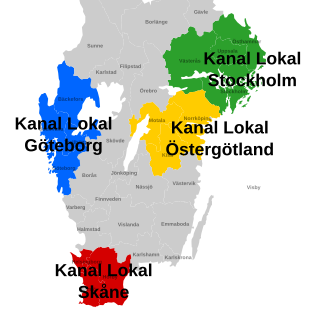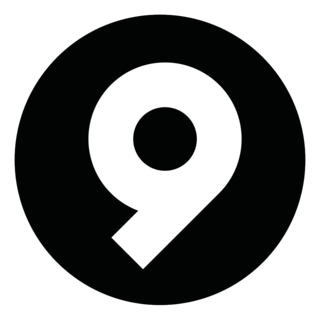Regular television broadcasts in the United Kingdom started in 1936 as a public service which was free of advertising, while the introduction of television and the first tests commencing in 1927. Currently, the United Kingdom has a collection of free-to-air, free-to-view and subscription services over a variety of distribution media, through which there are over 480 channels for consumers as well as on-demand content. There are six main channel owners who are responsible for most material viewed.

Sveriges Television AB, shortened to SVT, is the Swedish national public state-controlled television broadcaster, funded by a public service tax on personal income set by the Riksdag. Prior to 2019, SVT was funded by a television licence fee payable by all owners of television sets. The Swedish public broadcasting system is largely modelled after the system used in the United Kingdom, and Sveriges Television shares many traits with its British counterpart, the BBC.
Digital terrestrial television is a technology for terrestrial television in which land-based (terrestrial) television stations broadcast television content by radio waves to televisions in consumers' residences in a digital format. DTTV is a major technological advance over the previous analog television, and has largely replaced analog which had been in common use since the middle of the 20th century. Test broadcasts began in 1998 with the changeover to DTTV beginning in 2006 and is now complete in many countries. The advantages of digital terrestrial television are similar to those obtained by digitising platforms such as cable TV, satellite, and telecommunications: more efficient use of limited radio spectrum bandwidth, provision of more television channels than analog, better quality images, and potentially lower operating costs for broadcasters.
Canal Digital was a Nordic pay TV and internet service provider in Norway, Sweden, Denmark and Finland that was founded in March 1997 as a joint venture between the French pay TV company Canal+ and the Norwegian telecommunications operator Telenor.
Nickelodeon is a children's channel broadcasting in Denmark, Norway and Finland. It broadcasts programming from the similarly branded channels in the United Kingdom and the United States as well as a few locally produced programmes.

Kanal Lokal was the name of four local television channels that started broadcasting in Sweden in early autumn 2005. Kanal Lokal had four different broadcasting areas in the most populated areas of Sweden.
The television industry in Turkey includes high-tech program production, transmission and coverage. Turkish Radio and Television Corporation is Turkey's largest and most powerful national television station. As of 1st of August 2019, RTÜK states that there a total of 536 television channels in Turkey. Turkey is the world's fastest growing television series exporter and has currently overtaken both Mexico and Brazil as the world's second highest television series exporter after the United States. Turkish television drama has grown in since the early 2000s.

TV4 is a Swedish free-to-air television network owned by TV4 AB, a subsidiary of the Bonnier Broadcasting Group. It started broadcasting by satellite in 1990 and, since 1992, on terrestrial television. In 1994, TV4 became the largest channel and remained so for a number of years. The two channels of Sveriges Television (SVT) lost more and more viewers for a couple of years. After making schedule changes in 2001, SVT1 had practically the same numbers of viewers as TV4. From 2004 to 2019, the TV4 Group was a fully active member of the European Broadcasting Union.

TNT was a commercial television channel in Sweden. The channel was launched by the tabloid newspaper Aftonbladet as Aftonbladet TV7 on 9 October 2006. Aftonbladet sold the channel in late 2007. In August 2008, it was sold once again and is since owned by NonStop Television. On 2 March 2011 the channel was relaunched as TNT7, following Turner Broadcasting System's purchase of Millennium Media Group, the owner of NonStop Television. The channel is now called TNT since the seven was dropped from the name on 21 March 2012.

Kanal 9 is a Swedish free-to-air television channel owned by Discovery Communications. It targets the 25-59 age group, which is a slightly older age group than the sister channel Kanal 5. The channel launched on 25 February 2007. Its opening night featured the 79th Academy Awards. The programming consists of drama series, movies, sports and documentaries.
Digital terrestrial television was launched in Sweden in 1999. The shutdown of the analogue equivalent started on September 19, 2005, and was finalized on October 15, 2007.
National Geographic Channel is a Nordic free-to-air television channel broadcasting documentaries and related programmes to the Nordic countries.
DiTV is a Swedish television channel owned by the financial newspaper Dagens Industri.
Television in Denmark was established in the 1950s and was run by a monopoly with only one channel available until the 1980s.
Television began in Sweden in 1954 with test transmissions, prior to the opening of the first station, Radiotjänst, two years later. A second channel was launched in 1969. Commercial television arrived in the 1980s through cable television and in 1992, the country's first terrestrial commercial channel was launched.

Comedy Central in Sweden was a television channel owned by ViacomCBS Networks EMEAA, broadcasting to Sweden. Viacom International Media Networks have said that the channel will feature both original Swedish productions made for the channel and imported content.
Nickelodeon is a children's channel broadcasting to Sweden, the channels headquarters is based in the Netherlands.
In broadcasting, continuity or presentation is announcements, messages and graphics played by the broadcaster between specific programmes. It typically includes programme schedules, announcement of the programme immediately following and trailers or descriptions of forthcoming programmes. Continuity can be spoken by an announcer or displayed in text over graphics. On television continuity generally coincides with a display of the broadcaster's logo or ident. Advertisements are generally not considered part of continuity because they are advertising another company.
Boxer TV A/S is a company that is broadcasting pay television channels on the digital terrestrial television network in Denmark since February 1, 2009. It is a subsidiary of Boxer TV Access, a Swedish company which is owned by Com Hem.






